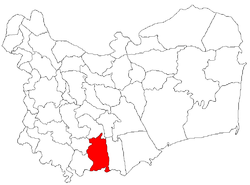Baia, Tulcea
| Baia | |
|---|---|
| Commune | |
 Location of Baia | |
 Baia Location of Baia | |
| Coordinates: 44°43′N 28°40′E / 44.717°N 28.667°ECoordinates: 44°43′N 28°40′E / 44.717°N 28.667°E | |
| Country | Romania |
| County | Tulcea |
| Component villages | Baia, Camena, Caugagia, Ceamurlia de Sus, Panduru |
| Government | |
| • Mayor | Nicolae Ionuş (since 2004) |
| Area | |
| • Total | 198.29 km2 (76.56 sq mi) |
| Population (2002) | |
| • Total | 5,024 |
| • Density | 25/km2 (66/sq mi) |
| Postal code | 827005 |
| Climate | Cfa |
| Website | www.cjtulcea.ro/judet/baia.html (Romanian) |
Baia is a commune in Tulcea County, Romania.
Villages
The commune includes five villages:
- Baia (Hamangia until 1929, Turkish: Hamamci)
- Camena
- Caugagia (Turkish: Kavgaci)
- Ceamurlia de Sus (Yeni Kazak until ca. 1855)
- Panduru (Potur until 1929)
History
Main article: Hamangia culture
In 1953, archaeological excavations on a site along the Lake Goloviţa, near Baia, led to the discovery of a new Middle Neolithic culture, named after the commune. Further research has shown that the culture, with Mediterranean origins, extended across Dobruja and North-Eastern Bulgaria. The culture's most notable artefact is an anthropomorphic statuette in terra cotta, known as The Thinker, which was discovered at Cernavodă.
References
This article is issued from Wikipedia - version of the 6/19/2016. The text is available under the Creative Commons Attribution/Share Alike but additional terms may apply for the media files.
